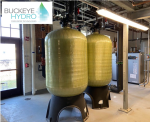My main motivation for softening water is not to save money, but to increase the quality of a touch free wash. If you're happy with your touch free wash performance and you've got a bunch of happy customers you need to take a harder look.
Pros: Your chemical cost may go down a little (maybe 10%) and your RO membranes will likely last a good bit longer. I get 5 years plus out of a membrane. Your touch free will likely clean better. You may be able to swap to a more economical chemical that is not hard water tolerant. There will be less residual hardness scale accumulation on the walls and equipment.
Cons: you will now have to purchase salt, which is getting more and more expensive. When I got in the business it was $3/bag, Now it's up to almost $10/bag. the cost of salt may negate any chemical cost savings. You will also have to periodically re-bed the softener maybe every five years, maybe every ten, at the cost of couple thousand dollars on a large twin tank. And a large twin tank takes up a lot of room.





